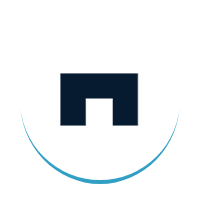Top 12 AI Companies in Healthcare to Watch in 2026
The healthcare industry is undergoing a significant transformation, driven by artificial intelligence that promises to enhance diagnostics, streamline operations, and personalize patient care. For CTOs, product leaders, and healthcare organizations, identifying the right partner or platform is critical for successful digital transformation. This comprehensive guide moves beyond surface-level descriptions to provide a detailed analysis of the leading ai companies in healthcare. We’ve curated a resource list to help you navigate this complex ecosystem, from established cloud marketplaces to specialized clinical AI platforms.
To understand the current landscape of innovation, consider exploring the leading Top Medical AI Companies in 2025 as a starting point. Our list builds on that foundation by offering practical insights and direct comparisons.
Inside this article, you will find a detailed breakdown of each company, including their core services, key differentiators, and real-world implementation considerations. We cut through the marketing copy to offer an honest assessment of each solution’s capabilities and limitations. Each entry includes direct links and screenshots to help you efficiently evaluate which platforms align with your specific needs, whether you require enterprise-grade healthcare software development, advanced business intelligence services, or a reliable AI solutions partner. This resource is designed to be your definitive guide for making informed technology decisions.
1. Bridge Global
Bridge Global stands out as a premier AI solutions partner for organizations seeking to embed artificial intelligence directly into their software development lifecycle. With two decades of agile delivery experience, they don’t just build software; they engineer AI-advantaged systems designed for efficiency, quality, and scalability. This makes them one of the most practical and well-rounded ai companies in healthcare, finance, and other regulated industries.
What sets them apart is their “AI-first” approach to custom software development. Instead of treating AI as an add-on, Bridge Global integrates it across the entire development process. This includes predictive risk detection, workflow automation, and continuous AI-driven quality assurance, which accelerates timelines and mitigates risks, a crucial factor in healthcare software development. Their service model is built for flexibility, offering everything from initial AI Discovery Workshops to full-scale product engineering with dedicated offshore teams.
Key Features & Use Cases
- End-to-End AI Integration: Bridge Global provides comprehensive ai development services that span the entire project, from initial strategy and data analysis to model deployment and ongoing maintenance. This unified approach ensures that AI is a core component, not a siloed feature.
- Agile, Cross-Functional Teams: Clients gain access to embedded remote teams that function as a direct extension of their in-house staff. This model is ideal for startups needing rapid MVPs and enterprises augmenting their capacity for complex digital transformation projects.
- Industry-Specific Compliance: With deep experience in regulated sectors, Bridge ensures that solutions meet strict security and compliance standards like HIPAA. Their portfolio of client cases demonstrates a proven track record in delivering secure and reliable software.
Practical Considerations
Pros:
- Proven agile methodology combined with an AI-first development process.
- Flexible engagement models with cost-efficient offshore teams.
- Strong expertise in regulated industries, including healthcare and finance.
- Comprehensive service portfolio covering everything from SaaS Consulting to IoT software development services.
Cons:
- Pricing is not publicly available and requires a custom quote, which can slow down initial budget comparisons.
- The primarily offshore delivery model may not suit organizations that require on-shore-only teams.
Website: https://www.bridge-global.com
2. AWS Marketplace – Healthcare and Life Sciences (AI/ML)
For organizations already embedded in the Amazon Web Services ecosystem, the AWS Marketplace is a powerful accelerator for sourcing and deploying specialized AI tools. It acts as a curated digital catalog of third-party AI and machine learning solutions specifically vetted for healthcare and life sciences. This platform simplifies procurement, allowing teams to purchase and deploy everything from clinical natural language processing (NLP) models to advanced imaging analytics directly through their existing AWS account.
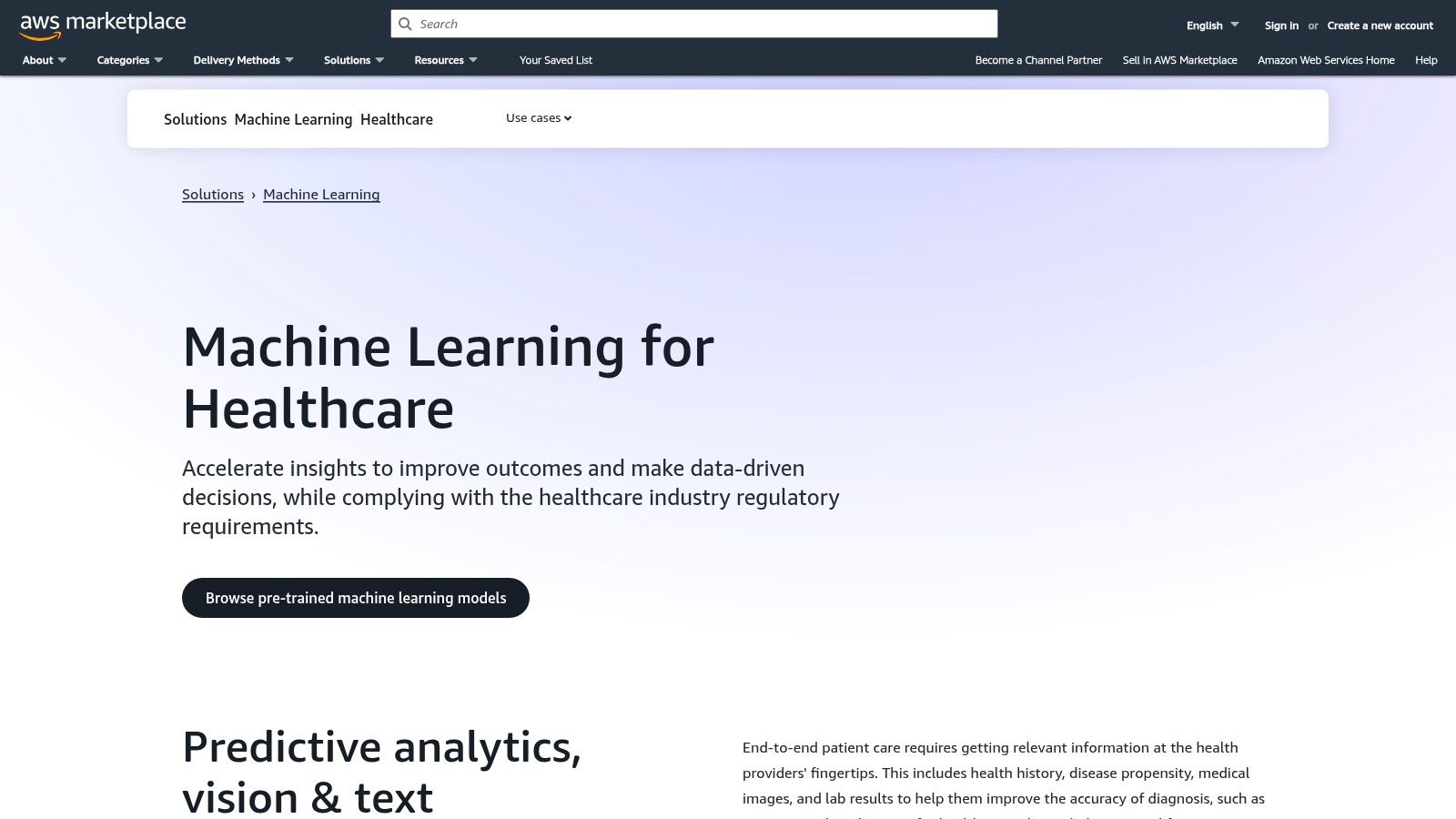
The key advantage is the streamlined integration and contracting process. Solutions can be deployed quickly into a secure Virtual Private Cloud (VPC) and often come with pre-built integrations for Amazon SageMaker. This is a significant time-saver, as it bypasses lengthy vendor negotiations with standardized enterprise agreements and consolidated billing. For deeper insights into AWS’s role in advancing AI, you can explore their initiatives, such as the AWS Imagine Grant leveraging Generative AI and Cloud Innovation.
Key Features and Considerations
| Feature | Description | Practical Implication |
|---|---|---|
| Consolidated Procurement | Purchase and manage third-party software licenses directly on your AWS bill. | Reduces administrative overhead and simplifies budget management for IT departments. |
| HIPAA-Eligible Services | Many listings are designed to support HIPAA compliance requirements. | Essential for organizations handling Protected Health Information (PHI), ensuring security. |
| Flexible Deployment | Offers various models like SaaS, APIs, AMIs, and container images. | Teams can choose the best integration method for their existing infrastructure. |
| Pricing Models | Includes free trials, pay-as-you-go, and private offers for custom terms. | Allows for testing solutions before committing and scaling costs with usage. |
Pros:
- Significantly reduces contracting cycle times with enterprise-ready legal templates.
- Offers a vast selection, from niche AI models to comprehensive platform services.
- Many solutions support trials and metered pricing, lowering the barrier to entry.
Cons:
- Pricing is often opaque, requiring contact with the vendor for a quote.
- Requires a skilled technical team to integrate and manage the solutions within clinical workflows.
Website: https://aws.amazon.com/marketplace/solutions/machine-learning/healthcare
For expert guidance on leveraging this platform, discover more about Amazon Web Services from Bridge Global.
3. Microsoft Azure Marketplace (Healthcare AI solutions)
For organizations building on Microsoft’s cloud infrastructure, the Azure Marketplace is an essential hub for discovering and deploying healthcare-focused AI solutions. It functions as a comprehensive catalog of consulting offers and deployable AI/ML tools, ranging from GenAI workshops and clinical documentation copilots to FHIR data pipelines and advanced imaging analytics. The platform is designed for seamless, Azure-native integrations, allowing companies to leverage services like Azure OpenAI, Fabric, and Health Data Services efficiently.
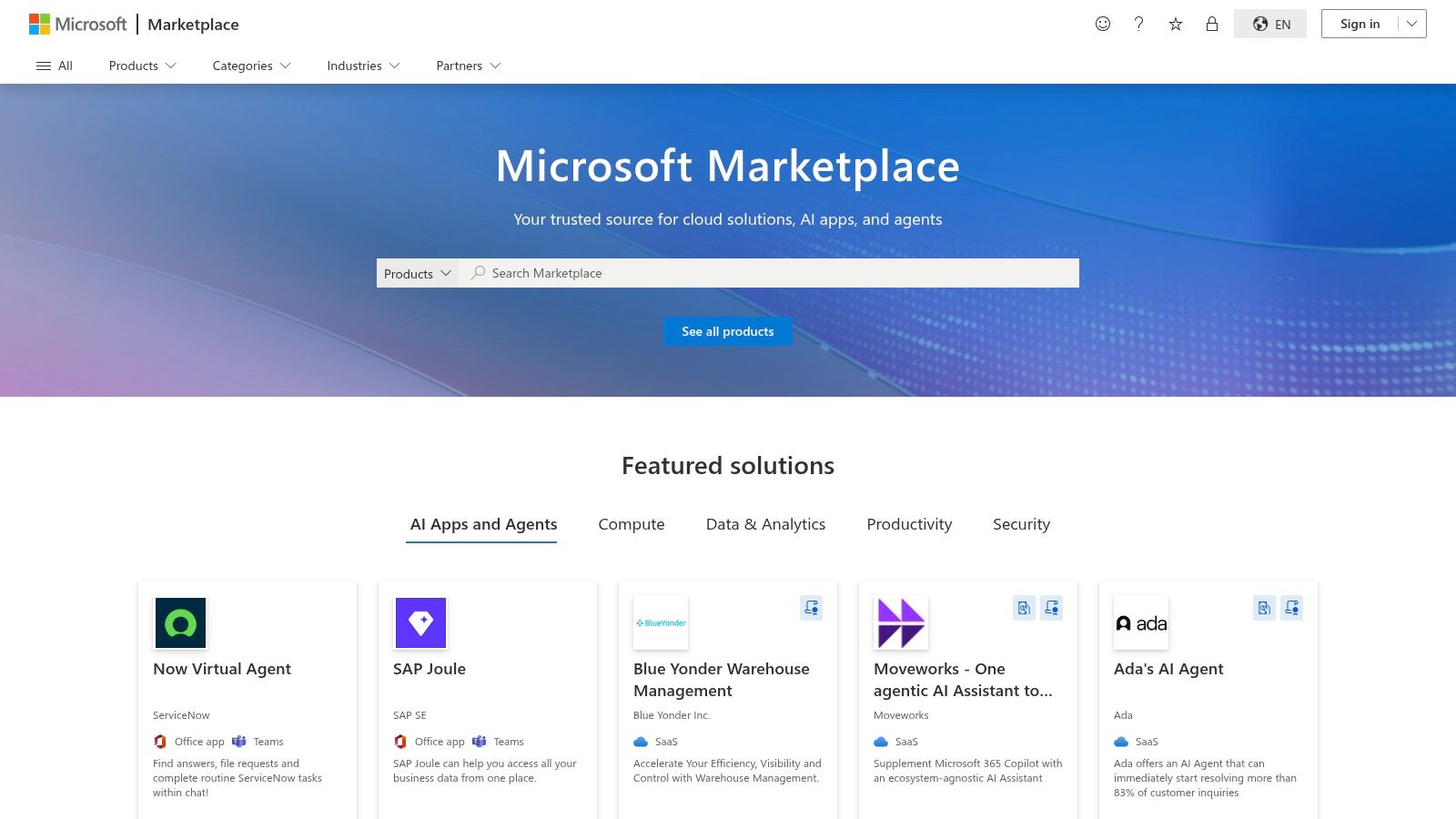
A key differentiator is its strong focus on enterprise procurement and governance. Solutions can be purchased directly through a Microsoft invoice, simplifying billing and budget management. Additionally, the marketplace features a large ecosystem of system integrators offering fixed-scope pilots and quick-start proofs of concept (POCs). This model significantly shortens the time-to-value for healthcare organizations looking to test and implement cutting-edge AI technologies.
Key Features and Considerations
| Feature | Description | Practical Implication |
|---|---|---|
| Azure-Native Integration | Solutions are built to integrate with Azure OpenAI, Fabric, and Health Data Services. | Ensures high performance and easier management for teams already using the Azure stack. |
| Enterprise Checkout | Centralized billing and governance through existing Microsoft enterprise agreements. | Streamlines procurement and enforces role-based access control (RBAC) for security. |
| Quickstart Offers | Many vendors provide fixed-scope pilots, workshops, and proof-of-concept packages. | Reduces the initial risk and cost of evaluating new AI solutions before full-scale adoption. |
| Large Integrator Ecosystem | A wide selection of certified partners offer specialized consulting and deployment services. | Provides access to expert support for complex implementations and customizations. |
Pros:
- Strong integrator ecosystem with many fixed-scope pilots accelerates innovation.
- Native tie-ins to Azure OpenAI, Document Intelligence, and FHIR services.
- Simplifies enterprise governance and procurement through consolidated billing.
Cons:
- Many listings are “contact for pricing,” which can make cost comparison difficult.
- The marketplace’s branding and structure can sometimes feel like they are evolving.
Website: https://azuremarketplace.microsoft.com
To get the most out of this platform, explore how experts can help you with Microsoft Azure from Bridge Global.
4. Google Cloud Marketplace (Healthcare & Life Sciences)
For organizations building on Google Cloud, the Marketplace serves as a centralized hub for discovering and deploying vetted healthcare and life sciences AI solutions. It provides a curated selection of third-party SaaS, APIs, and containerized applications that are contract-ready and validated for the Google Cloud ecosystem. This significantly simplifies the procurement process, enabling teams to purchase and deploy solutions directly while counting the spend toward their existing Google Cloud commitments.
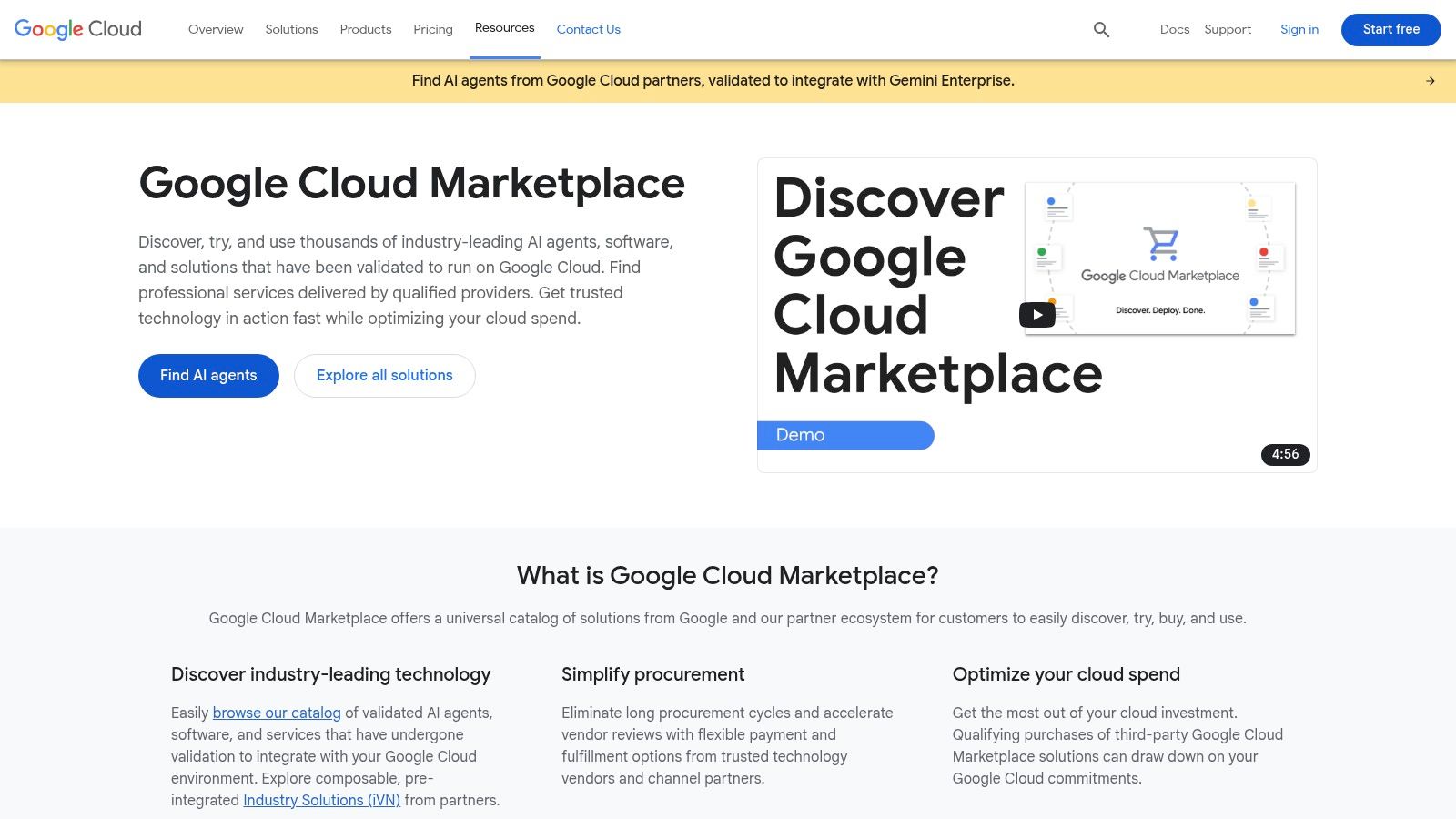
The primary benefit is the native integration with Google’s powerful AI and data services, such as Vertex AI and the Cloud Healthcare API. This allows for a more seamless data flow and model deployment pipeline, making it an ideal choice for teams that want to leverage Google’s advanced infrastructure without lengthy vendor negotiations. The platform’s consolidated billing and governance features, like Private Marketplace, provide IT leaders with control and visibility over software acquisition.
Key Features and Considerations
| Feature | Description | Practical Implication |
|---|---|---|
| Commitment Drawdown | Purchases can count toward an organization’s committed Google Cloud spend. | Maximizes the value of existing cloud contracts and simplifies budgeting. |
| Native Integration | Solutions integrate with Vertex AI, Cloud Healthcare API, and Medical Imaging Suite. | Accelerates the development and deployment of AI-powered healthcare applications. |
| Consolidated Billing | All third-party software purchases appear on a single Google Cloud bill. | Streamlines vendor management and reduces administrative complexity for finance teams. |
| Flexible Pricing & Trials | Offers free trials, usage-based pricing, and credits for some solutions. | Allows teams to test and validate tools in a sandbox environment before full commitment. |
Pros:
- Procurement simplicity and the ability to draw against existing Google commitments.
- Access to a growing list of live HCLS vendors and cloud-native services.
- Strong foundation for building and scaling custom AI applications on a secure platform.
Cons:
- Requires an established Google Cloud tenancy and familiarity with its IAM setup.
- Many solutions still require significant IT effort for integration into clinical workflows.
Website: https://cloud.google.com/marketplace
Leveraging these platforms requires deep technical expertise, which is where an experienced AI solutions partner can provide immense value.
5. Epic Connection Hub (Epic Showroom)
For healthcare organizations using the Epic electronic health record (EHR), the Epic Connection Hub is an indispensable resource for discovering compatible AI tools. It functions as a public directory where technology vendors list applications designed to interoperate seamlessly with the Epic ecosystem. This “showroom” helps provider buyers identify and shortlist AI solutions, from imaging triage to clinical documentation tools, with a high degree of confidence that they will integrate into existing workflows.
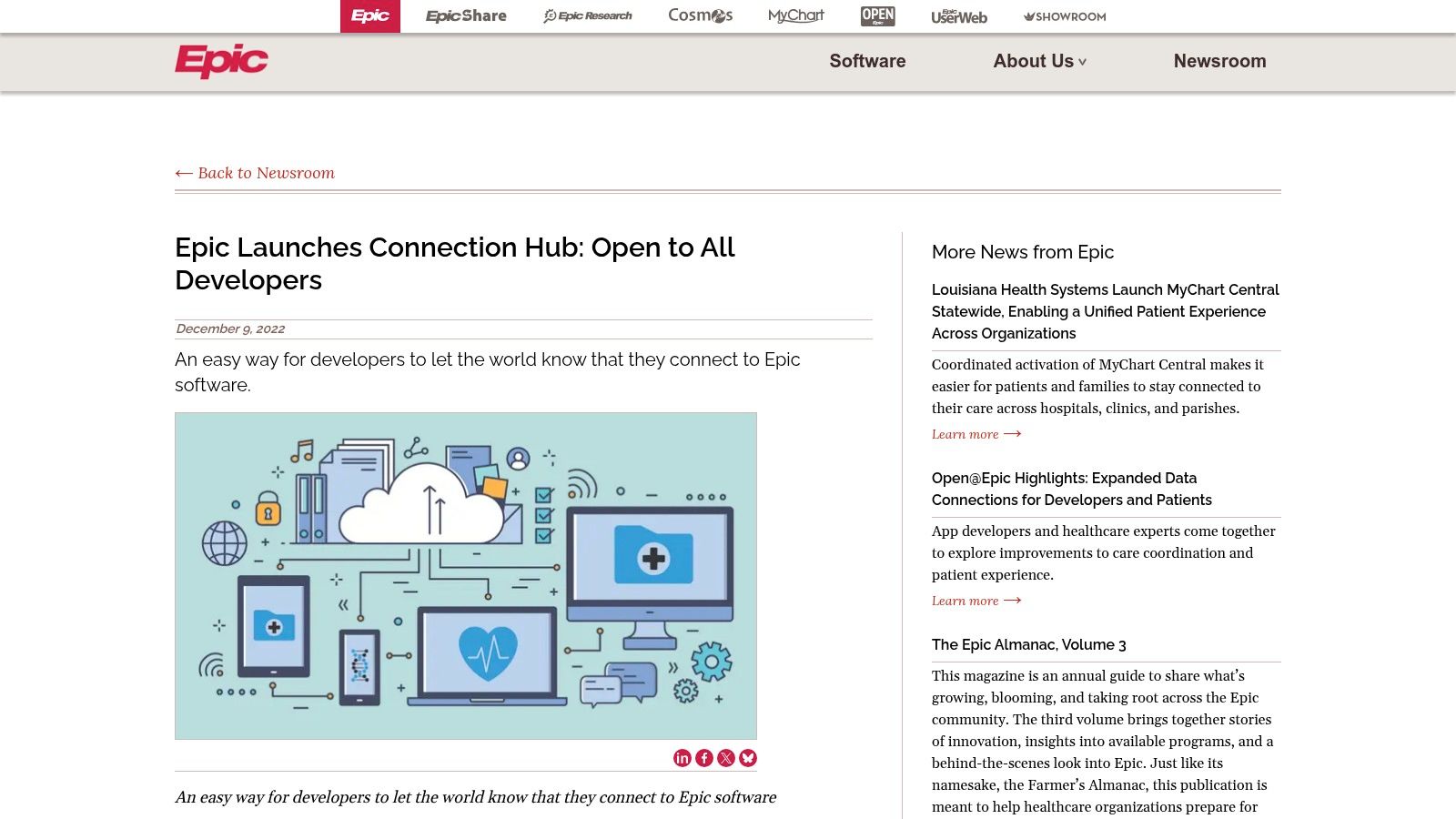
The primary benefit is the significant reduction in integration risk and uncertainty. By featuring vendors that have already established connectivity at other Epic sites, the hub allows health systems to focus on clinical value rather than technical hurdles. It complements Epic’s developer resources by showcasing market-ready applications, making it a crucial first stop for innovation teams. For organizations planning such integrations, partnering with a firm specializing in healthcare software development can ensure a smooth implementation process.
Key Features and Considerations
| Feature | Description | Practical Implication |
|---|---|---|
| Interoperability Showcase | Vendors report their interoperability details and connection status with Epic. | Provides a transparent view of which AI tools are “Epic-ready,” saving research time. |
| Direct Vendor Links | Listings include links to product pages, demos, and contact information. | Facilitates direct engagement with vendors for procurement and due diligence. |
| Free to Browse | The directory is publicly accessible at no cost for health systems. | Lowers the barrier for IT and clinical teams to explore innovative AI solutions. |
| Complements Developer Tools | Works alongside Open.Epic and other vendor services for deeper integration work. | Serves as the discovery phase before technical teams use developer APIs. |
Pros:
- Streamlines the discovery of AI applications already integrated at other Epic sites.
- No cost to browse, helping teams reduce integration unknowns early in the vendor selection process.
- Provides transparency into the growing ecosystem of AI companies in healthcare focused on EHR enhancement.
Cons:
- Functions purely as a directory; purchasing and contracting happen directly with vendors.
- Information is vendor-maintained, so independent due diligence is still essential.
Website: https://www.epic.com/epic/post/epic-launches-connection-hub/
6. Oracle Health – Healthcare Marketplace and Developer Program
For healthcare systems heavily invested in the Cerner Millennium EHR, the Oracle Health Developer Program and Marketplace is the designated gateway for innovation. It serves as a centralized hub for discovering validated third-party applications, accessing FHIR APIs, and leveraging developer sandboxes. This platform is specifically designed to help organizations extend the capabilities of their core EHR with specialized AI-driven tools, directly from vendors who have met Oracle’s integration standards.
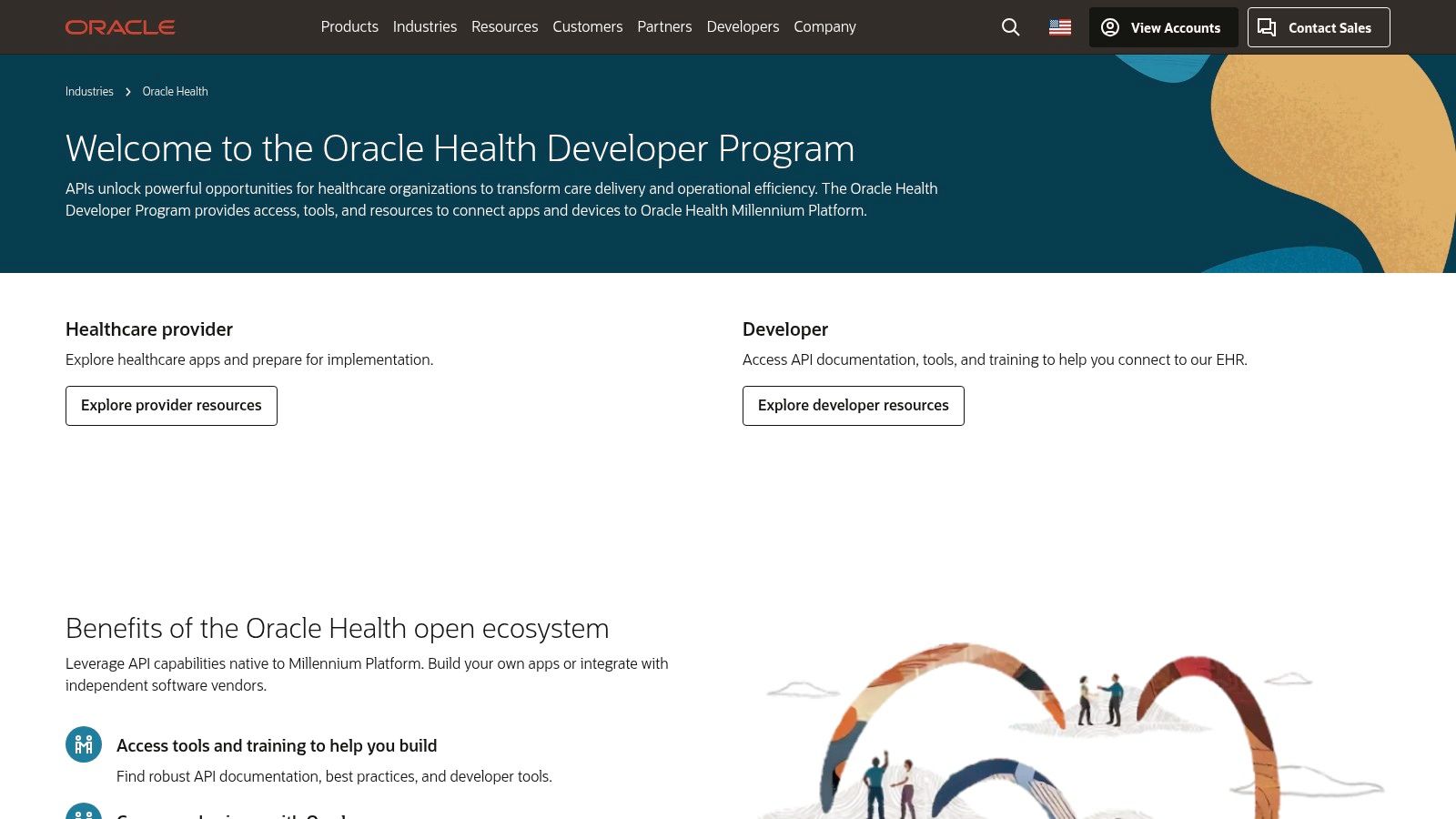
The primary value is its focus on creating a structured path for both developers and providers within the Oracle ecosystem. Unlike broader marketplaces, it offers transparent API fee schedules and clear guidelines for contracting and implementation through the Oracle PartnerNetwork (OPN). This makes it a crucial resource for any AI companies in healthcare looking to integrate with or build upon the Cerner platform, ensuring a more predictable commercialization and deployment process.
Key Features and Considerations
| Feature | Description | Practical Implication |
|---|---|---|
| Validated Partner Apps | A curated catalog of applications validated for Cerner Millennium integration. | Providers can browse solutions with confidence that they meet baseline technical requirements. |
| Published API Access | Offers transparent fee schedules and access to developer sandboxes and training. | Developers can accurately budget and plan for integration costs and timelines. |
| Provider Implementation Guidance | Provides a framework for contracting and implementing solutions via the OPN. | Streamlines the procurement and deployment process for hospital IT departments. |
| Direct Vendor Contact | Functions as a lead generation hub to connect providers directly with app vendors. | Facilitates direct negotiation and relationship-building for custom agreements. |
Pros:
- Transparent API fee information and published environment access options.
- Provider-focused guidance simplifies contracting and implementation.
- Ensures a degree of interoperability for solutions built for the Cerner ecosystem.
Cons:
- Marketplace primarily facilitates introductions; purchases are direct vendor-to-provider.
- Some Oracle PartnerNetwork services are limited to U.S.-based Millennium environments.
Website: https://www.oracle.com/health/developer/
For organizations needing a partner to navigate these integrations, exploring healthcare software development expertise can provide the necessary support.
7. Nuance (Microsoft) Precision Imaging Network – AI Services Catalog
For healthcare organizations invested in the Nuance ecosystem, the Precision Imaging Network is a streamlined gateway to deploy third-party imaging AI. Functioning as a specialized services catalog, it integrates a curated selection of AI algorithms directly into the widely used Nuance PowerScribe and PowerShare platforms. This model is exceptionally effective for enterprise buyers who need to distribute AI-powered diagnostic tools into existing radiology reporting and image-sharing workflows at scale.
The primary advantage is the deep workflow integration, which accelerates adoption by presenting AI insights directly within the radiologist’s familiar environment. This embedded approach minimizes disruption and training overhead. The network centralizes access to regulated, clinically validated AI applications from various vendors, simplifying the otherwise complex process of sourcing, contracting, and implementing disparate AI tools. This makes it a key resource among ai companies in healthcare focused on operational efficiency.
Key Features and Considerations
| Feature | Description | Practical Implication |
|---|---|---|
| Integrated AI Catalog | A marketplace of AI algorithms for various modalities (CT, MR, XR) and body regions. | Provides a single point of access to diverse, pre-vetted AI tools without managing multiple vendors. |
| Native Workflow Distribution | Delivers AI results directly into Nuance PowerScribe reporting and PowerShare networks. | Boosts radiologist adoption and efficiency by embedding insights at the point of care. |
| Regulated Partner Ecosystem | Partners with established AI vendors who meet regulatory and clinical standards. | Ensures that the deployed algorithms are reliable, safe, and compliant for clinical use. |
| Centralized Management | Simplifies the procurement, deployment, and management of multiple imaging AI applications. | Reduces the administrative and technical burden on IT and clinical imaging departments. |
Pros:
- Leverages a massive installed base, dramatically speeding up AI adoption and rollout.
- Offers a curated, high-quality channel aware of complex regulatory and clinical needs.
- Improves radiologist efficiency by integrating AI insights directly into reporting software.
Cons:
- Primarily benefits organizations already using the Nuance ecosystem; others may face integration hurdles.
- Pricing is not always transparent and requires negotiation with Nuance and its partners.
For organizations seeking to build similar integrated platforms, a partner with deep experience in healthcare software development is essential.
8. Blackford – Medical Imaging AI Platform and Marketplace
Blackford provides a vendor-neutral platform designed to simplify the evaluation, procurement, and deployment of medical imaging AI applications. It functions as a centralized marketplace and orchestration engine, allowing healthcare systems to integrate a vast portfolio of radiology and operational AI tools into their existing PACS and clinical workflows. This single-point-of-contact approach is ideal for organizations looking to scale their AI initiatives without the complexity of managing multiple individual vendor integrations.
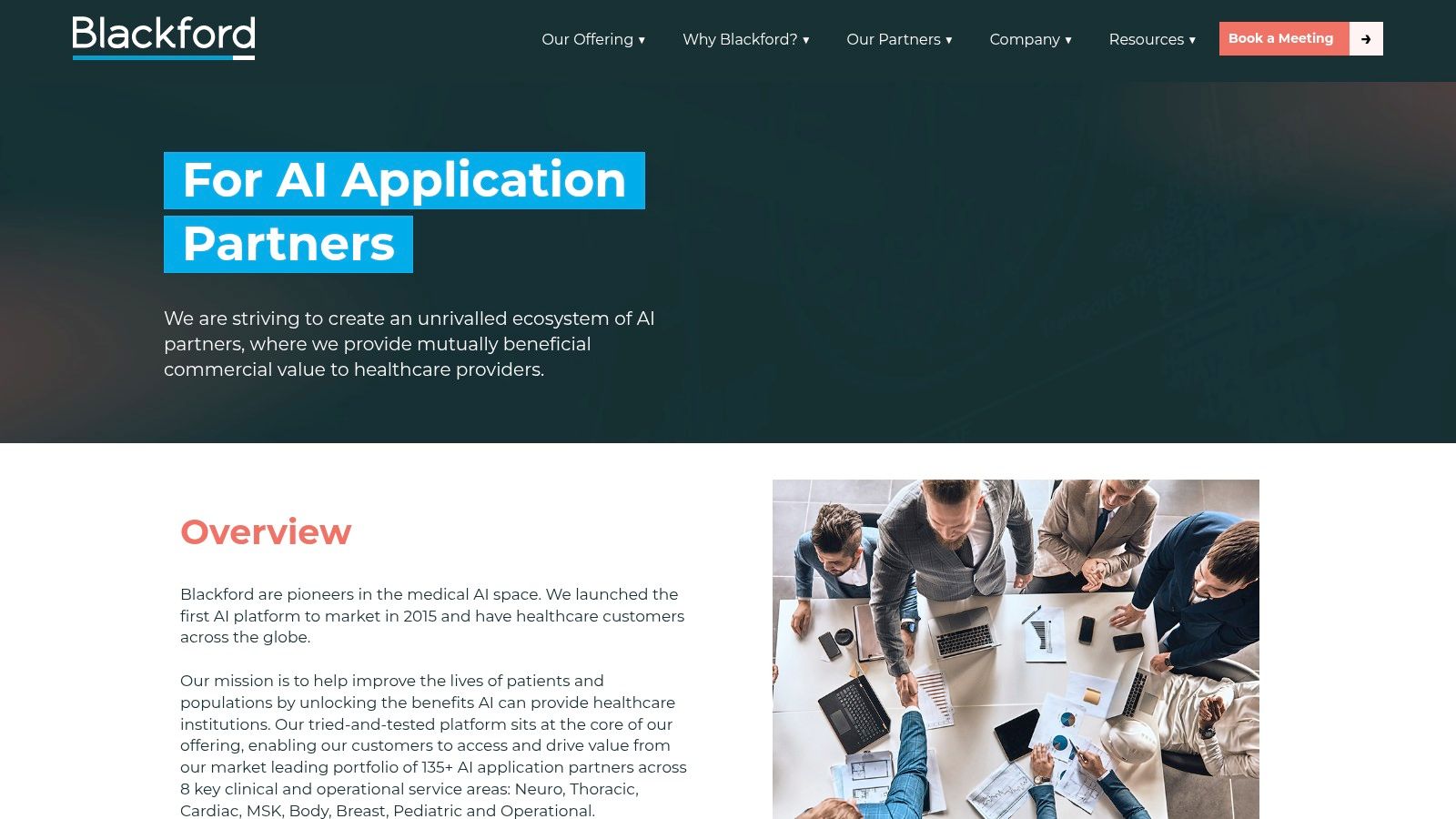
The platform’s core value lies in reducing IT overhead and streamlining the entire AI lifecycle. By providing a unified infrastructure, Blackford allows clinical teams to trial and adopt applications across specialties like neuro, cardiac, and thoracic imaging through one consistent interface. This model makes it one of the more practical AI companies in healthcare for large systems aiming to manage a diverse set of imaging algorithms efficiently. Partnering with an expert in healthcare software development can help institutions maximize the value of such platforms.
Key Features and Considerations
| Feature | Description | Practical Implication |
|---|---|---|
| Vendor-Neutral Platform | Integrates with a wide range of AI applications from different vendors. | Provides flexibility and choice, preventing vendor lock-in for specific algorithms. |
| Centralized Orchestration | Manages the routing of studies to appropriate AI models and returns results to worklists. | Eliminates the need for multiple point-to-point integrations, simplifying IT infrastructure. |
| Curated AI Portfolio | Offers a pre-vetted marketplace of applications across multiple clinical specialties. | Accelerates the evaluation process and ensures access to clinically validated tools. |
| Unified Lifecycle Management | Handles contracting, deployment, monitoring, and updates from a single interface. | Reduces the administrative burden on procurement and IT departments. |
Pros:
- Significantly reduces IT complexity and overhead by consolidating AI integrations.
- A single platform simplifies the entire process of evaluating, contracting, and monitoring AI apps.
- Offers a broad, curated selection of applications to meet diverse clinical needs.
Cons:
- Primarily focused on imaging AI, with limited offerings for non-imaging applications.
- The enterprise sales model requires a quote and often involves multi-year commitments.
Website: https://blackfordanalysis.com/providers/ai-application-partners
9. Viz.ai – AI-Powered Care Coordination Platform
Viz.ai has established itself as a leader among AI companies in healthcare by combining advanced, FDA-cleared imaging analysis with a powerful care coordination platform. It moves beyond simple diagnostics by using AI to detect critical conditions like strokes and aneurysms in medical scans, then automatically alerting and mobilizing the entire care team. This integration of AI-powered detection with communication tools is designed to drastically reduce time-to-treatment for time-sensitive emergencies, directly impacting patient outcomes.
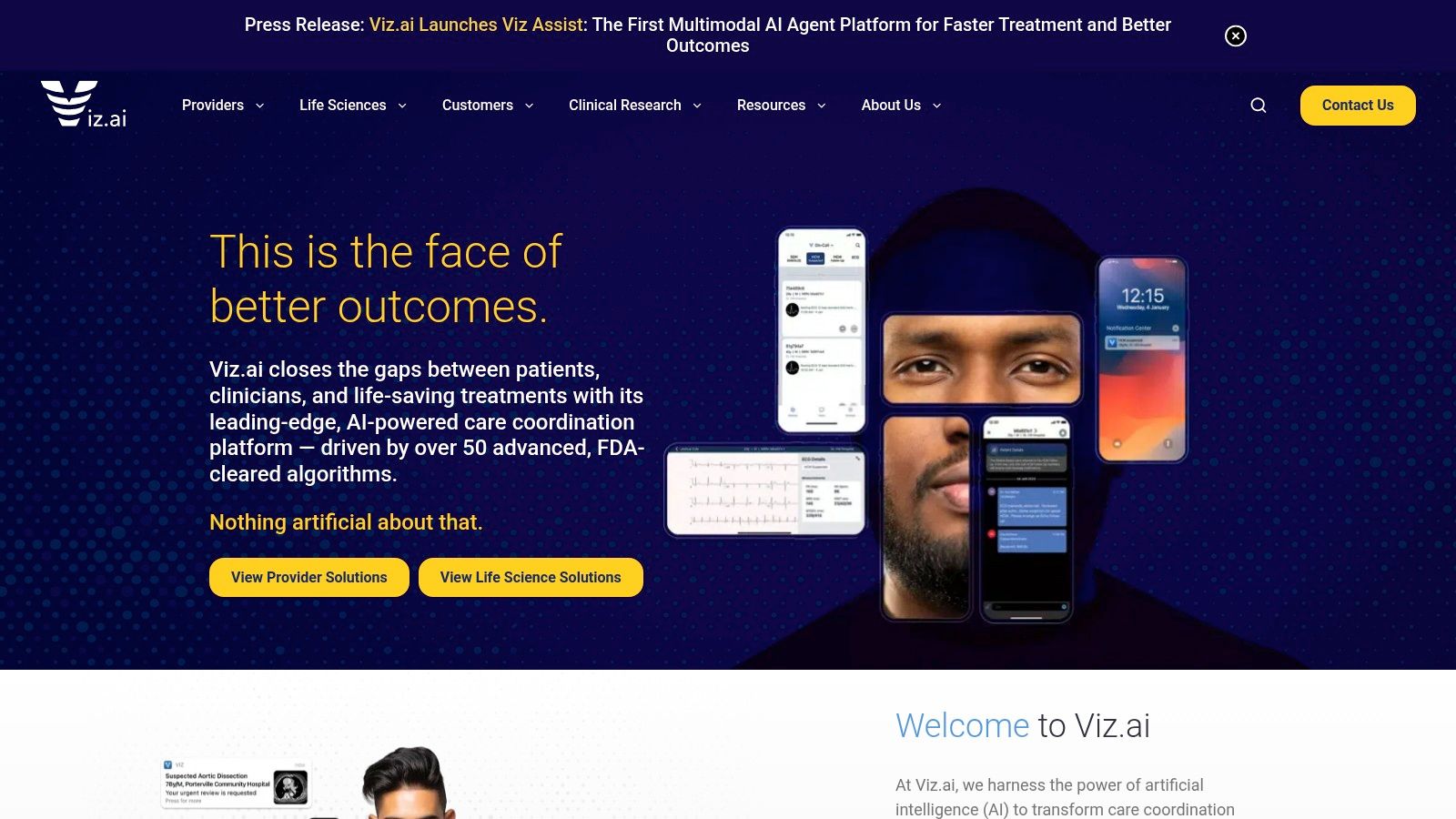
The platform’s key differentiator is its focus on the entire clinical workflow, not just the scan. It provides specialists with mobile access to high-fidelity images and facilitates secure, real-time communication between radiologists, neurologists, and surgeons. By streamlining decisions and logistics, Viz.ai helps hospital networks standardize care pathways and ensure patients receive the fastest possible intervention, which is critical in stroke and cardiac care. Implementing such a system requires careful integration, often managed through dedicated healthcare software development projects.
Key Features and Considerations
| Feature | Description | Practical Implication |
|---|---|---|
| Broad FDA-Cleared Algorithms | Offers over 50 FDA-cleared algorithms for various conditions (stroke, aneurysm, etc.). | Provides a single, unified platform for multiple service lines, reducing vendor complexity. |
| Integrated Care Coordination | Combines AI alerts with secure messaging and mobile image viewing. | Accelerates the entire care pathway from diagnosis to treatment by connecting the team instantly. |
| End-to-End Pathways | Includes modules for managing patient pathways and life sciences data. | Supports clinical research and helps optimize operational efficiency across the hospital network. |
| 24/7 Support | Provides around-the-clock implementation and clinical support for users. | Ensures high uptime and assists clinicians in adopting the technology effectively into their workflows. |
Pros:
- Proven to reduce treatment times in U.S. stroke networks, with strong clinical adoption.
- Offers a broad and expanding menu of FDA-cleared algorithms in a single platform.
- Strongly aligns with clinical workflows, making it intuitive for care teams to use.
Cons:
- Pricing is available only by quote through an enterprise contracting process.
- Requires significant IT integration with imaging systems (PACS/VNA) and governance approvals.
Website: https://www.viz.ai/
10. Aidoc – Clinical AI for Imaging and Beyond
Aidoc is a leading AI company in healthcare, specializing in AI-powered imaging solutions that assist radiologists in flagging acute abnormalities. The company’s aiOS (AI Operating System) is an enterprise-grade platform that integrates a suite of FDA-cleared algorithms directly into existing clinical workflows. This “always-on” functionality allows for the automatic detection and prioritization of time-sensitive conditions, such as stroke and pulmonary embolism, directly from medical scans.
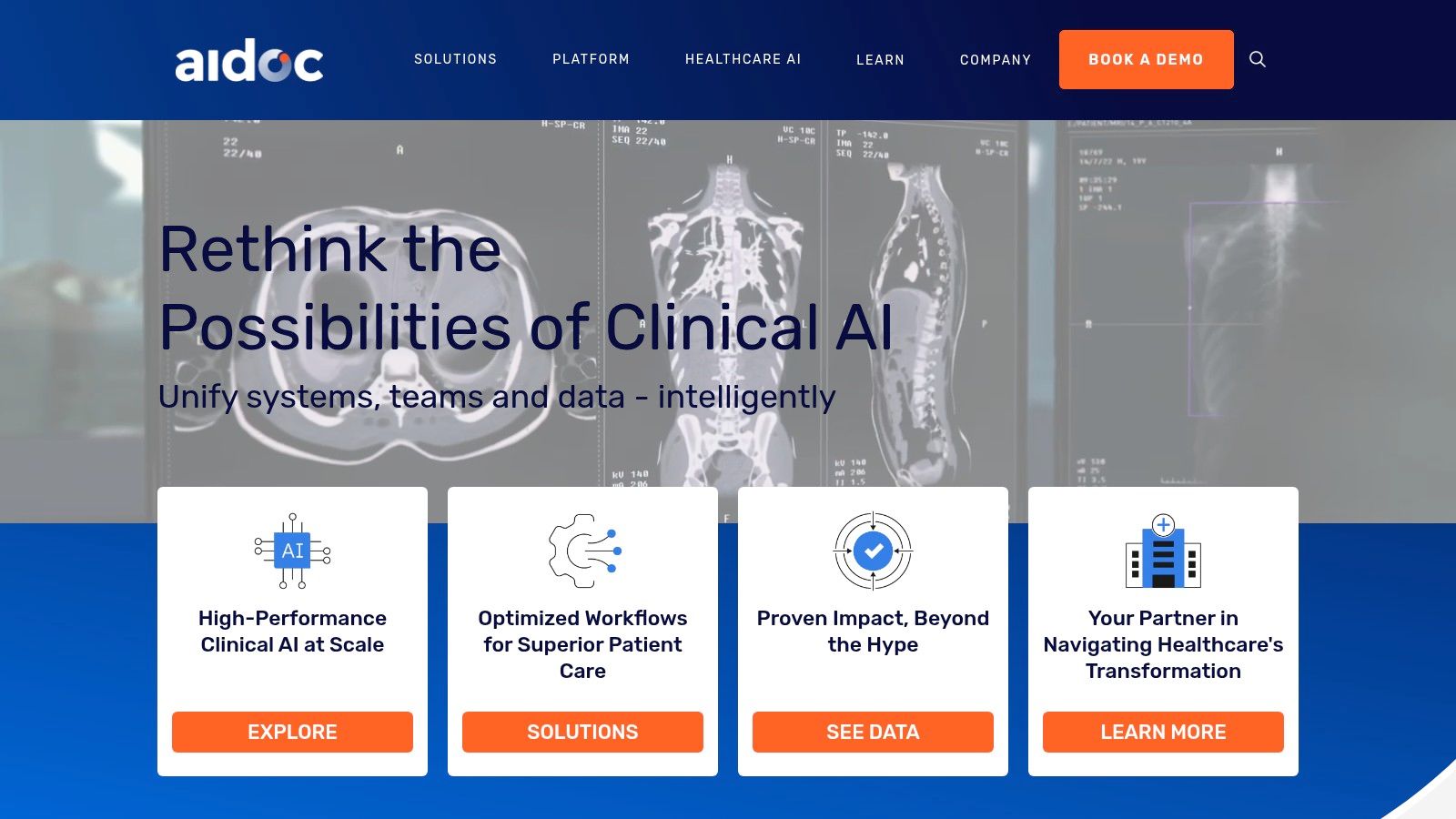
The platform’s primary advantage is its ability to reduce turnaround times and improve care coordination by delivering actionable insights at the point of care. By orchestrating AI across various specialties, Aidoc helps health systems scale their AI initiatives without adding significant IT overhead. This unified approach ensures that critical findings are communicated efficiently, enabling faster and more accurate diagnostic decisions. For organizations looking to implement similar intelligent systems, it’s beneficial to explore advanced machine learning services from Bridge Global.
Key Features and Considerations
| Feature | Description | Practical Implication |
|---|---|---|
| Multiple FDA Clearances | A comprehensive portfolio of algorithms cleared for clinical use, including a complete stroke package. | Provides high clinical confidence and regulatory assurance for deployment in patient care. |
| Triage & Prioritization | AI models automatically analyze scans to flag and prioritize cases with suspected critical findings. | Helps radiologists focus on the most urgent cases first, significantly reducing time to diagnosis. |
| Unified aiOS Platform | A single platform that manages the deployment and integration of various AI algorithms across the enterprise. | Simplifies IT management, avoids vendor sprawl, and ensures consistent workflow integration. |
| Workflow Integration | Seamlessly integrates with existing PACS, EMR, and communication systems used by care teams. | Minimizes disruption for clinicians and ensures AI-driven insights are delivered within their native environment. |
Pros:
- Strong clinical validation and a significant number of FDA clearances, particularly for stroke care.
- The unified aiOS platform reduces vendor management complexity for health systems.
- Proven to accelerate time-to-treatment in time-sensitive, life-threatening conditions.
Cons:
- Pricing is available only by quote and implementation success depends on the maturity of imaging IT infrastructure.
- Deployment requires significant cross-departmental approval from IT, radiology, and compliance teams.
Website: https://www.aidoc.com/
11. Tempus – AI-Enabled Precision Medicine (Tempus Hub)
Tempus is a leading technology company making precision medicine a reality by applying artificial intelligence in healthcare. For clinicians, particularly in oncology, the Tempus Hub platform provides a streamlined workflow for ordering advanced genomic and clinical tests, such as its nationally available, FDA-approved xT CDx 648-gene panel. This platform is designed to seamlessly integrate into clinical practice, offering EHR integrations that allow for ordering and receiving AI-driven reports directly within existing systems.
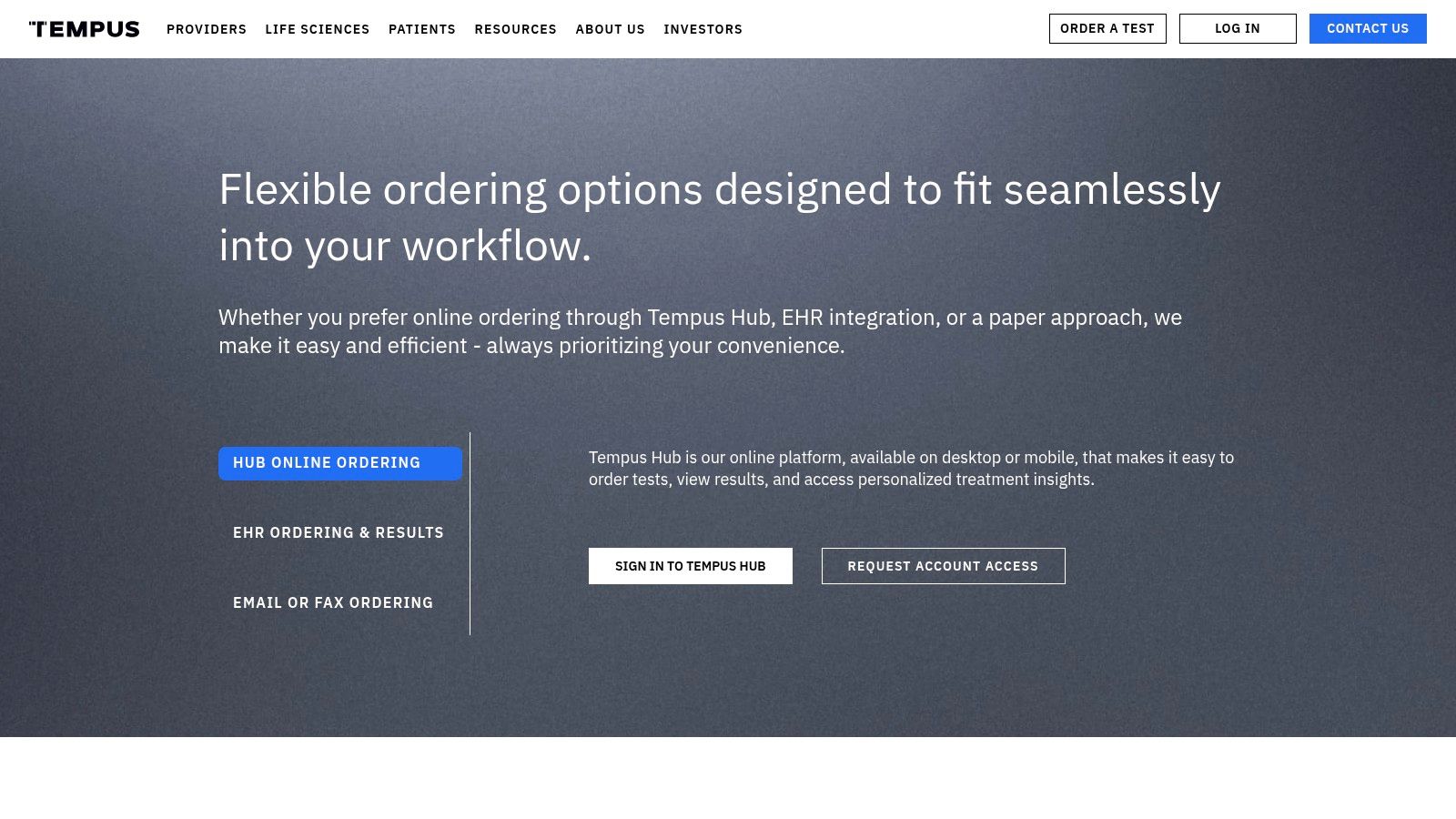
The company’s core strength lies in its ability to structure vast amounts of molecular and clinical data to make it accessible and useful for physicians. Tempus supports the entire process with services like mobile phlebotomy and financial assistance programs, aiming to remove barriers to accessing cutting-edge diagnostics. This comprehensive approach positions Tempus as a key player among AI companies in healthcare, bridging the gap between complex genomic data and actionable clinical insights.
Key Features and Considerations
| Feature | Description | Practical Implication |
|---|---|---|
| Clinician Ordering Portal | The Tempus Hub allows clinicians to order tests and view results through a dedicated portal. | Simplifies the test ordering process, saving time and reducing administrative burdens. |
| EHR Integration | Provides capabilities for ordering and receiving results directly within a clinic’s EHR system. | Enhances workflow efficiency and ensures that crucial data is part of the patient record. |
| AI-Driven Reports | Delivers comprehensive reports that use AI to synthesize genomic and clinical data. | Provides actionable insights to help guide personalized treatment decisions for patients. |
| Comprehensive Support | Offers mobile phlebotomy, financial assistance, and other patient support services. | Improves patient access to advanced testing and reduces logistical challenges for clinics. |
Pros:
- Strong U.S. support services and multiple ordering options, including direct EHR integration.
- Offers nationally available, FDA-approved genomic assays for clinical use.
- Focuses on making complex data actionable for clinicians in real-world settings.
Cons:
- Services are designed for clinician use and are not available direct-to-consumer.
- Pricing is not transparent, as it depends on insurance coverage and billing processes.
Website: https://www.tempus.com/order/
For organizations looking to build similar integrated platforms, explore our healthcare software development solutions.
12. Butterfly Network – Handheld Ultrasound with Embedded AI
Butterfly Network is transforming point-of-care diagnostics by integrating AI directly into a handheld, whole-body ultrasound device. Its website serves as the direct-to-provider e-commerce hub for purchasing the Butterfly iQ3 hardware and its accompanying cloud-based software subscription. This platform democratizes medical imaging, allowing healthcare professionals to buy a powerful diagnostic tool online and have it shipped quickly, a significant departure from traditional capital equipment procurement cycles.
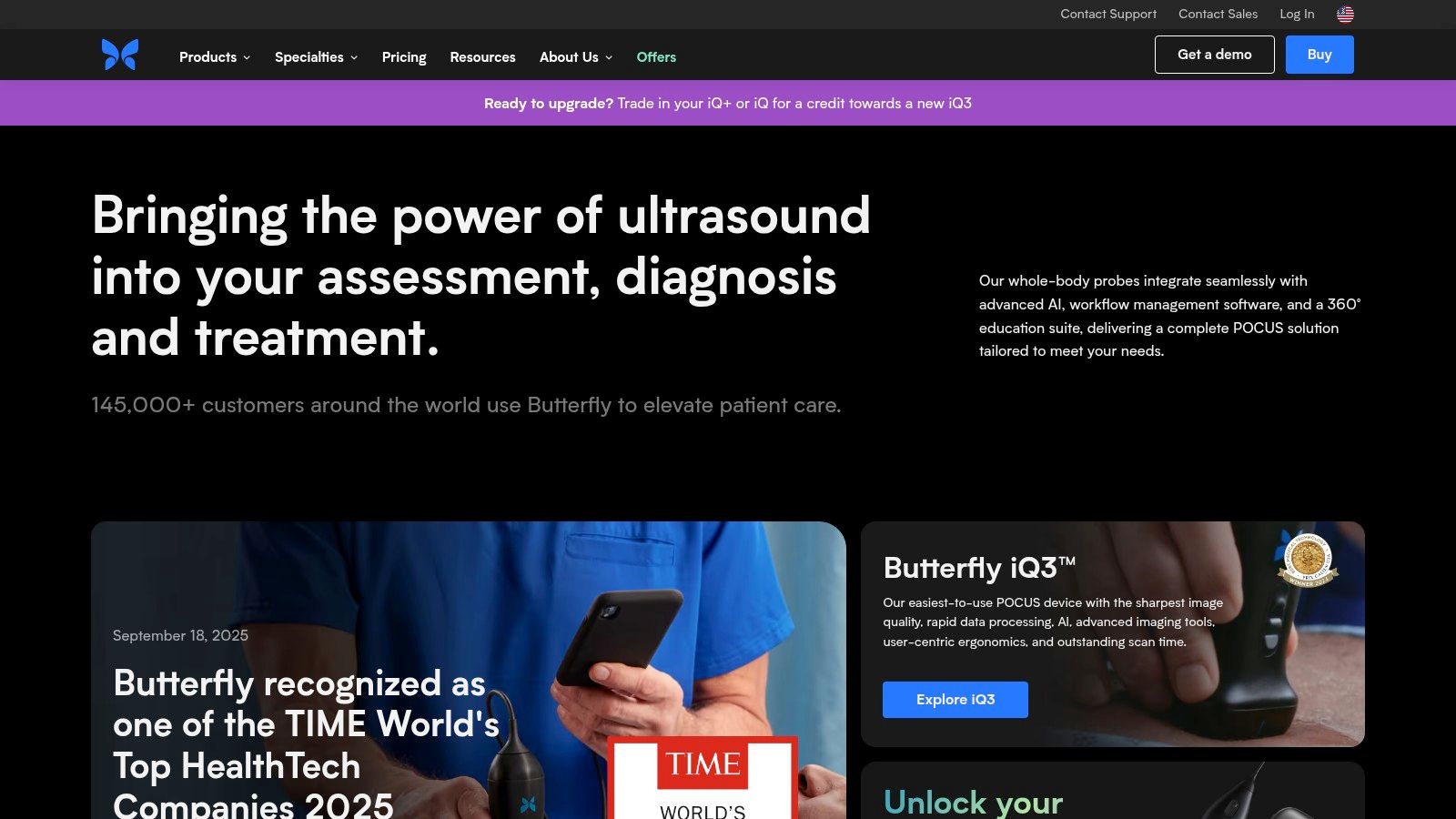
The core value lies in its vertically integrated ecosystem. The AI-powered software provides real-time guidance to help users capture high-quality images and offers educational tools, making advanced imaging more accessible. This model is ideal for clinics, individual practitioners, and hospital departments seeking to expand their diagnostic capabilities without the bulk and expense of traditional ultrasound systems. By combining hardware, software, and AI, Butterfly Network stands out as one of the most innovative ai companies in healthcare.
Key Features and Considerations
| Feature | Description | Practical Implication |
|---|---|---|
| Direct E-commerce | Purchase hardware and software membership tiers directly from the website (U.S.). | Streamlines the procurement process for providers, bypassing lengthy sales cycles. |
| Integrated AI Guidance | AI features assist with probe positioning, image acquisition, and interpretation. | Lowers the skill barrier for performing ultrasounds, enabling wider clinical adoption. |
| Portable Hardware | The Butterfly iQ3 is a pocket-sized, whole-body ultrasound probe. | Enables true point-of-care diagnostics in any setting, from clinics to remote locations. |
| Cloud-Based Platform | Securely store, share, and review ultrasound studies from any device. | Facilitates seamless collaboration, telemedicine consultations, and EMR integration. |
Pros:
- Convenient online purchasing in the U.S. with fast shipping options available.
- Broad point-of-care utility enhanced by integrated AI and educational content.
- A single probe solution covers a wide range of clinical presets and applications.
Cons:
- Requires both a device purchase and a recurring annual software subscription plan.
- The ecosystem is closed, focused exclusively on Butterfly’s hardware and software.
Website: https://www.butterflynetwork.com/
For organizations looking to build similar integrated device and software solutions, exploring healthcare software development expertise can provide the necessary technical foundation.
Top 12 Healthcare AI Solutions Comparison
| Provider | Core features | Target audience | Unique selling points | Pricing / procurement | Recommendation |
|---|---|---|---|---|---|
| Bridge Global | AI embedded across SDLC: generative AI, ML, data science, ChatGPT, cloud, full‑stack, UI/UX, QA, IoT, SaaS; AI Discovery Workshops | Startups (MVPs), mid‑market & enterprise (healthcare, finance, e‑commerce, ERP/CRM) | 20 years agile delivery, predictive risk detection, automation & continuous AI QA, consultative discovery, cross‑functional offshore teams | Custom scoped engagements — contact for tailored quote | Recommended — end‑to‑end AI-first development partner |
| AWS Marketplace – Healthcare & Life Sciences (AI/ML) | Vetted catalog of third‑party AI/ML (SaaS/APIs/AMIs/containers), SageMaker integrations | Healthcare teams wanting consolidated procurement & cloud deployment | Consolidated AWS billing, private offers, HIPAA‑eligible options, pay‑as‑you‑go trials | Vendor-dependent; many pay-as-you-go or contact-for-pricing | Good for procuring off‑the‑shelf AI modules |
| Microsoft Azure Marketplace (Healthcare AI) | Azure-native AI/ML listings deployable to Azure OpenAI, Fabric; consulting & pilot offers | Organizations using Azure seeking native integrations & pilots | Strong integrator ecosystem, fixed‑scope pilots, native Azure OpenAI/Fabric ties | Often contact-for-pricing; enterprise checkout on Microsoft invoices | Best for Azure-aligned solutions and pilots |
| Google Cloud Marketplace (Healthcare & Life Sciences) | HCLS curated solutions, Vertex AI integration, SaaS/APIs/GKE apps | Teams on Google Cloud seeking procurement simplicity & native deployment | Draws against committed spend, trials/credits, integration with Vertex AI & Cloud Healthcare API | Vendor-varied; some transparent pricing for core cloud services | Good for Google Cloud–native deployments |
| Epic Connection Hub (Epic Showroom) | Public directory of Epic‑compatible apps, interoperability details & demos | Provider buyers using Epic EHRs | Transparent view of apps already connected to Epic; reduces integration unknowns | Free to browse; purchases handled directly with vendors | Useful for shortlisting Epic‑compatible solutions |
| Oracle Health – Marketplace & Developer Program | App browsing for Cerner/Oracle partners, FHIR APIs, sandboxes & developer resources | Organizations in Oracle/Cerner ecosystems | Published API fee info, sandboxes, provider contracting guidance via OPN | Vendor quotes; some published API fee schedules | Best for Oracle/Cerner‑integrated projects |
| Nuance (Microsoft) Precision Imaging Network – AI Catalog | Catalog of imaging AI integrated into PowerScribe/PowerShare workflows | Enterprises wanting imaging AI distributed into radiology reporting | Workflow distribution at scale, regulated-aware channel, large installed base | Contracts via Nuance/partners; pricing by quote | Good when using the Nuance ecosystem |
| Blackford – Medical Imaging AI Platform | Vendor‑neutral orchestration, curated radiology AI portfolio, lifecycle management | Health systems evaluating/deploying many imaging AI apps | Single platform to evaluate, deploy & monitor many apps; reduces IT overhead | Enterprise pricing by quote; often multi‑year | Ideal for centralized multi‑vendor imaging programs |
| Viz.ai – AI‑Powered Care Coordination | FDA‑cleared imaging AI, alerts, team activation, mobile & desktop viewers | Stroke networks and acute care services | 50+ FDA‑cleared algorithms, proven adoption in stroke workflows, team activation features | Enterprise contracting; pricing by quote | Best for stroke and time‑sensitive care coordination |
| Aidoc – Clinical AI for Imaging | FDA‑cleared radiology AI suite with aiOS orchestration, triage & prioritization | Health systems needing validated radiology triage & enterprise workflow integration | Strong clinical validation, unified platform across specialties | Pricing by quote; requires IT/radiology/compliance sign‑off | Good for enterprise triage and prioritization |
| Tempus – AI‑Enabled Precision Medicine (Tempus Hub) | Genomic & clinical testing, Tempus Hub ordering, EHR integrations, AI reports | Oncology clinicians & labs needing integrated genomic testing | FDA‑approved assays, AI‑driven reports, ordering/results integration, support services | Pricing depends on payer coverage; list prices not shown | Best for integrated genomic diagnostics |
| Butterfly Network – Handheld Ultrasound w/ AI | Portable Butterfly iQ3 device, embedded AI scanning guidance, cloud software & app ecosystem | Point‑of‑care providers needing portable imaging | Buy online, AI guidance & education tools, evolving app ecosystem | Device purchase plus annual software plans; pricing varies by configuration | Good for point‑of‑care imaging and rapid deployment |
Choosing Your Path: How to Partner for Success in Healthcare AI
The healthcare landscape is undergoing a profound transformation, and the diverse array of ai companies in healthcare we’ve explored illustrates the breadth and depth of this revolution. From comprehensive cloud marketplaces like AWS and Microsoft Azure to specialized platforms like Viz.ai for care coordination and Tempus for precision medicine, the common thread is clear: AI is no longer a futuristic concept but a present-day catalyst for better patient outcomes, operational efficiency, and groundbreaking research.
Our journey through these innovative tools and platforms has highlighted several critical takeaways. We’ve seen that success isn’t just about adopting AI, but about adopting the right AI. The most impactful solutions are those deeply integrated into clinical workflows, addressing specific, high-value problems, whether it’s accelerating diagnostic imaging with Aidoc or democratizing medical imaging with Butterfly Network’s handheld ultrasound. The distinction between a platform, a marketplace, and a standalone solution is crucial; your organization’s technical maturity and strategic goals will dictate which model offers the best fit.
Your Next Steps: From Selection to Implementation
Choosing the right partner is a strategic decision that extends far beyond a feature comparison. As you evaluate these ai companies in healthcare, consider a multi-faceted approach to ensure a successful partnership and a strong return on investment.
Here are the key factors to guide your selection process:
- Define Your Core Problem: Before browsing solutions, clearly articulate the problem you need to solve. Are you looking to reduce diagnostic turnaround times, optimize patient scheduling, or analyze genomic data for personalized medicine? A well-defined problem is your most important filter.
- Assess Integration Capabilities: The most sophisticated AI tool is useless if it cannot integrate with your existing Electronic Health Record (EHR), Picture Archiving and Communication System (PACS), and other critical systems. Investigate API availability, data interoperability standards (like HL7 and FHIR), and the vendor’s experience with systems like Epic or Cerner.
- Evaluate Clinical and Regulatory Validation: Scrutinize the vendor’s clinical evidence, FDA clearances or other regulatory approvals, and real-world case studies. Look for partners who are transparent about their model’s performance metrics and limitations. A review of a company’s client cases can provide invaluable insight.
- Consider Scalability and Support: Your needs will evolve. Partner with a company that offers scalable cloud services and a robust support infrastructure. Can their solution grow with your patient volume? What does their technical and clinical support model look like post-implementation?
Once you’ve selected a partner, the implementation phase begins. This requires a dedicated internal team, clear communication channels with the vendor, and a phased rollout plan to manage change and train staff effectively. This process is often a complex undertaking, blending technical deployment with clinical workflow redesign. Many organizations find that collaborating with an expert AI solutions partner can de-risk this process, ensuring that the chosen tool is not just installed but truly integrated and adopted.
The future of medicine is being built today through the strategic application of artificial intelligence. By carefully selecting partners that align with your clinical needs, technical infrastructure, and long-term vision, your organization can move beyond aspiration and begin delivering a more intelligent, efficient, and personalized standard of care.
Navigating the complexities of AI integration requires more than just technology; it requires a strategic partner. Bridge Global specializes in healthcare software development and custom AI development services, helping organizations build and implement secure, compliant solutions that connect seamlessly with their existing workflows. Let us help you translate AI for your business potential into clinical reality.
